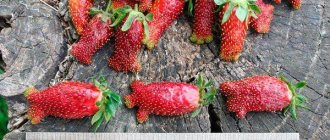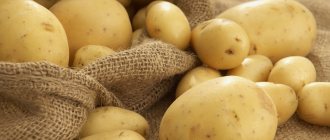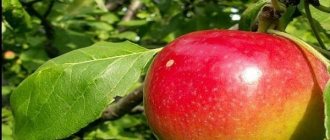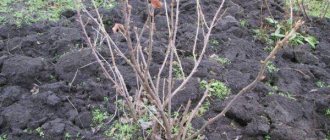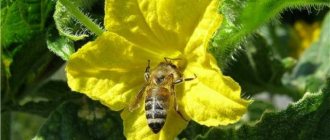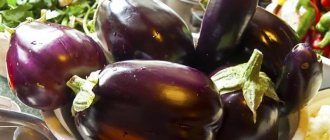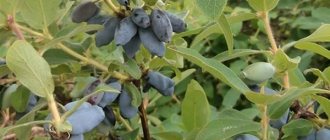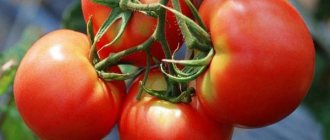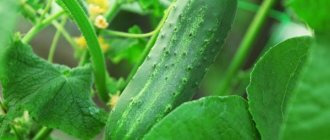A real apple grows in the garden without added nitrates. The Avgustovskoe variety has apples with excellent taste.
By planting this fruit crop on your site, you will enjoy the fragrant fruits already in the summer.
There is not a single person in the modern world who has not heard of the apple tree.
This is such a widespread fruit crop that not a single store counter is complete without these healthy and tasty fruits.
But it is worth distinguishing between the concepts of “fresh” and “processed” apple.
Although the purchased fruits look fresh, in fact they are mostly treated with chemicals that maintain their presentation. Apples from your own apple tree will avoid this problem.
Description
Apple tree Augusta is a variety with late-summer ripening of apples .
The fruit crop was bred not so long ago, in 1982, at the All-Russian Scientific Research Institute for Selection of Horticulture and Horticulture by crossing the Papirovka tetraploid and Orlik varieties. The authors of the apple tree are Russian breeders: Sedov E.N., Dolmatov E.A., Serov Z.M., Sedysheva G.A.
All-Russian Research Institute of Genetics and Selection of Fruit Plants named after I.V. Michurin.
In 2002, the variety was tested in the State Register and was zoned to all territories of Russia, as well as to Ukraine, Bashkiria and Belarus.
In order not to confuse the variety with other apple crops, you should familiarize yourself with it in more detail and find out all the additional characteristics
additional characteristics
Advantages and disadvantages
A distinctive feature of the summer apple tree is its high winter hardiness.
Additional advantages of the variety include the following:
- High yield;
- Commercial quality of fruits;
- Immunity to scab.
Disadvantages include short shelf life of fruits.
Dimensions of an adult tree
Apple tree "Augusta".
The skeletal branches extend from the trunk at right angles, with a large distance from each other.
The tree forms a wide, spreading, unthickened crown with a diameter of up to 2.5 - 3 m . An adult apple tree reaches 4 – 4.5 m in height.
Leaf color and size
- of the apple tree are medium in size, inclined towards the bottom.
- The foliage is light green, wrinkled, large-wide, oval in shape. The edges are large - crenate.
- The plates are concave, slightly lowered.
Annual growth
The fruit crop grows very quickly. Annual growth averages 7–10 cm.
Periodicity in fruiting
Despite the dry summer or frosty winter, the fruiting of the apple tree is consistently regular , without periodicity.
Productivity
- The fruits are green, with a bright, rich, blurred blush.
- Oblong in shape, with beveled edges.
- Weighing 160 – 210 g.
- The variety is valued for its high yield. At maturity, one tree bears up to 120 kg of fruit.
Tasting assessment
The fruit crop has apples that not only have a beautiful appearance, but also have high taste qualities:
- The pulp of the fruit is very juicy, dense, granular, light green in color, with a dessert, sweet and sour taste.
- The tasting score is 4.5 points.
Winter hardiness
In winter, at minus temperatures of 35 degrees, the crown and root system of a tree rarely freezes over.
Due to its high resistance to harsh winters, the variety is becoming increasingly popular in the Northern regions of Russia.
You should know! When rootstocked for winter varieties of apple trees, Augusta is able to withstand sub-zero temperatures of up to 43 degrees.
Disease resistance
The fruit crop is immune to scab and powdery mildew.
But there are cases of infection with Cytosporosis . This is a fungus of parasitic origin that affects the bark of a tree.
It usually occurs when the soil is poor and watering is not regular.
Further care for the Augusta apple tree
Although this variety is unpretentious, a number of agrotechnical procedures must be carried out correctly, otherwise the tree may reduce productivity and may also be damaged by pathogenic microorganisms.
Irrigation regime
Particular attention should be paid to watering young Augusta apple trees - they need to be moistened regularly and abundantly so that the tree develops better. During the rainy season, tree trunk circles are loosened more often to remove the crust that forms on the soil surface.
Otherwise, oxygen and moisture will not be able to reach the root system. During periods of drought, the amount of watering is increased.
Feeding fruit trees
The Augusta apple tree variety requires mandatory fertilizing, especially if the soil on the site is not very fertile - the yield of a given fruit tree directly depends on the amount of fertilizer applied.
The first fertilizing is applied in early spring, before the buds swell. The next application of fertilizers is carried out in the last ten days of May - the first ten days of June. In the first season, this apple tree is fed with fertilizers containing large amounts of nitrogen - this mineral activates the growth of vegetative mass and roots.
From the second season until the start of fruiting, the Augusta apple tree is fed with fertilizers that contain more potassium and phosphorus.
Procedure for pruning an Augusta apple tree
If you correctly form the crown of the Augusta apple tree, you can achieve an earlier start of fruiting.
Photo of apple tree pruning diagram
The tree is pruned for the first time immediately after planting in a permanent place. During this procedure, it is necessary to trim all shoots so that the height of the central trunk is no more than 1 m, and the height of the side branches is 15-20 cm less than the central trunk. This pruning of the Augusta apple tree activates the growth of side shoots.
In the future, every spring it is necessary to carry out sanitary pruning, during which all dried, damaged shoots are removed.
Reviews
Dubov. K. Gorno - Altaisk. “Summer, autumn, and winter apple trees grow in our garden plot. Of the summer varieties, Augusta is the most productive hybrid . We harvest up to 80 kg of fruit from one tree. Apples are of excellent commercial and consumer quality. We sell about 30 kg of fresh fruits, we process the rest and sell them in canned form to local buyers.”
Anastasia. Leningrad region. “Long-term practice in gardening allows us to call the Augusta apple tree the most productive variety. This fruit crop not only bears fruit regularly, but also does not allow a decrease in yield. The apple tree is unpretentious in care. Resistant to diseases and pests. The only drawback is that the fruits have a short shelf life.”
Filippova Oksana. Tyumen. “Among the other fruit crops that grow on our plot, I would classify the Augusta apple tree as a medium variety. Apart from tasty fruits and high yields, which sometimes decrease, there is nothing else that can be attributed to the positive features of the variety. In winter, the apple tree freezes over; in summer it requires constant watering. The foliage is often affected by scab, which ultimately takes a lot of time to care for. The fruits, although tasty, do not last long. Before choosing this seedling, I advise you to check with the seller, ask for a description, photo, and understand whether it is suitable for development in your region.”
Diseases and pests
This fruit tree has high resistance to scab and powdery mildew.
However, if the soil on which the apple tree grows is severely depleted and watering is not regular, the crop may be damaged by cytosporosis. The fungus that causes the disease usually affects the bark of the trunk and shoots.
The main pests that can attack this fruit tree are:
- aphid;
- mite;
- apple moth;
- codling moth;
- slowpoke.
Pests in the garden!
Leaf roller How to deal with cutworms Spider mites
The easiest way to fight these pests is with tobacco infusion, to which soap is added. It is best to use nitrophen (3% solution) against fruit mites.
Advice!
When fighting fruit mites on an apple tree in early spring and autumn, you need to remove all affected shoots and treat the cut areas with garden varnish.
Features of planting and care
Autumn planting of an apple tree.
In order for the fruit crop to take root well and develop properly, the planting site is chosen on the sunny side, with a groundwater level of at least 3 m.
Landing
Deadlines
The seedling should be planted in early spring before the buds open.
Important! If the apple tree was purchased in the fall, the tree should simply be buried and the planting itself should be carried out in the spring.
Technology
- In a properly selected area, dig a hole 40 cm deep and 50 cm wide.
- Sand is poured onto the bottom and a seedling is installed, the rhizomes are carefully distributed in the form of a fan and covered with soil.
- Here it should be taken into account that the root collar is not deepened; it should be 3 cm above ground level.
- After the work is completed, compact the tree trunk circle and water it with 2 buckets of water.
Distance
Caring for apple trees in August.
The August apple tree requires good lighting ; in its absence, the yield decreases sharply.
To prevent this, you should consider the distance between plants when planting.
A distance of 4 m is maintained between apple trees and 5 m between rows.
Growing
In order for the apple tree to develop well, during drought it is watered abundantly .
If the summer is rainy, the soil near the tree trunk is regularly loosened, which allows the root system to receive the necessary amount of air.
Agricultural technology
Timely fertilizing of the fruit crop will contribute to better tree growth.
In the first years after planting the seedling, nitrogen fertilizers are applied in the spring.
After 2 years, potassium and phosphorus fertilizers begin to be applied.
Pruning and crown formation
Proper crown formation promotes early fruiting.
The first pruning is carried out immediately after planting ; the top part of the seedling is cut off so that the height of the tree does not exceed 1 m. Thanks to this, the side shoots will begin to grow quickly and form fruit shoots.
Then, every year in the spring, all weak and damaged branches of the apple tree are cut off.
Pollinator varieties
For an apple tree to produce well, it requires cross-pollination . All summer varieties with one flowering period will serve for this purpose.
Agricultural technology for growing the Augusta apple tree variety
You should buy seedlings in specialized nurseries or from trusted sellers to be sure that the desired variety will be purchased.
When purchasing, you should pay attention to the condition of the roots and shoots of the young tree - they must be strong, without visible damage or signs of disease. The roots should be about 40 cm in length, their number should be at least 5. At least 3-4 skeletal branches should extend from the main trunk.
The place for planting the Augusta apple tree should be well lit and level. If the apple tree does not have enough light, this will affect the yield, which will decrease sharply, and the color of the fruit will become more faded.
This apple tree does not like too wet soils, so groundwater should not come closer to the soil surface than 3-3.5 m. It should not be planted in lowlands, where it is often too cool and humid.
Detailed information on growing Augusta apple trees - video
[media=
https://youtu.be/CZ7Hy27iIQk
]
The soil on the site should be loose, allowing moisture and oxygen to pass well to the roots of the tree. The best soils for growing Augusta apple trees are loam or sandstone. If the soil is too clayey, then sand and humus should be added to it - at least 5.5-6 kg of each of these fertilizers should be applied to each square of soil.
This fruit crop is planted in any region only in the spring before sap flow begins.
Advice!
When buying Augusta apple tree seedlings in the fall, you just need to dig them in, and in the spring, transplant the tree to a previously prepared place.
If you plan to plant several seedlings, then you need to maintain certain distances between them in a row - at least 4 m. And the row spacing should be about 4.5-5 m.
Stages of planting an Augusta apple tree:
- The planting hole for this tree is dug in advance - its width should be slightly larger than the size of the root system, and its depth should be about 0.35-0.4 m.
- A layer of sand is laid on its bottom, from which a mound is formed in the center of the pit.
- A stake is driven in next to the mound to which the seedling will be tied.
- A tree is placed in the center of the hole on a mound of sand, the roots are carefully straightened, then the hole is filled with a nutrient substrate. The root collar should be 4.5-5 cm above ground level. It cannot be buried in the soil.
- The soil needs to be compacted, then water is added under each tree - at least 15-20 liters.
Features of ripening and fruiting
In additional characteristics of the variety we will describe the timing of fruiting, as well as ripening and storage of fruits.
Fruiting
Start
The first appearance of fruits on an apple tree occurs 5–6 years after planting.
If the crown is formed in a timely manner and pruning is carried out, the first yield appears in the 4th year.
Peculiarities
The variety has record yields at the first fruiting - 25 kg of apples per tree.
The peculiarities of the apple tree include the fact that with each subsequent year the yield increases several times.
Deadlines
Fruit ripening
Regional climatic conditions affect the timing of fruit ripening. On average, harvesting occurs in the middle - end of August .
Fruit storage
Consumption of fresh fruits is short-lived. One month after picking, the apples become deformed and lose their consumer qualities .
Advice! Since the yield is very high, in order to prevent the fruits from rotting, they should be processed immediately after picking.
Pros and cons of fruit crops
Each crop has both good and bad sides, and the Augusta apple tree variety is no exception. The following advantages can be listed:
- high resistance to cold;
- high yield;
- good commercial properties;
- there is immunity against scab.
The disadvantage of the Augusta variety is its short shelf life.


